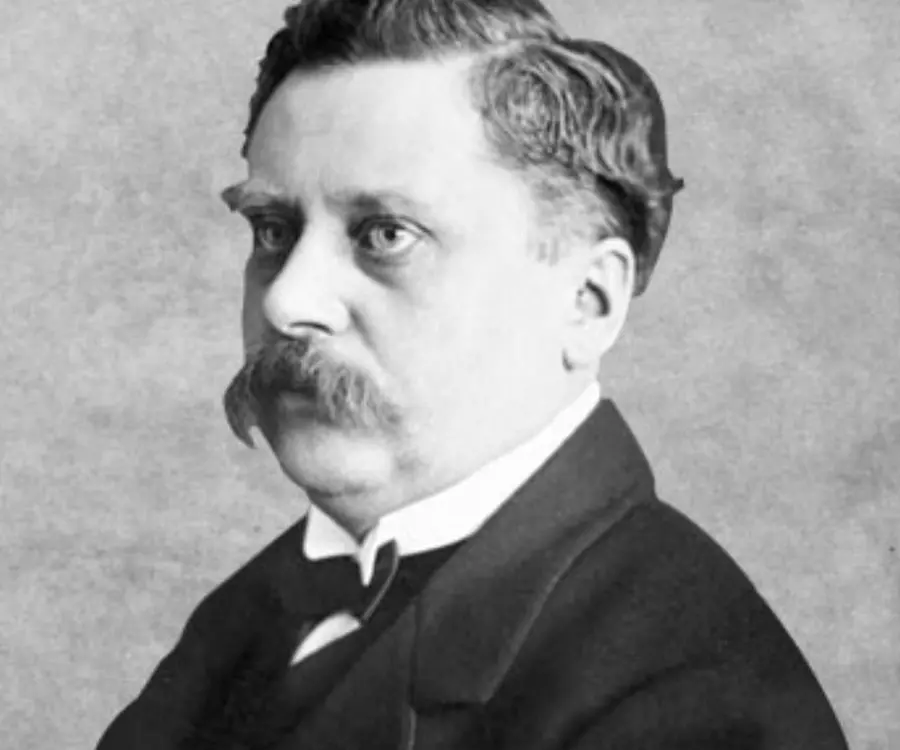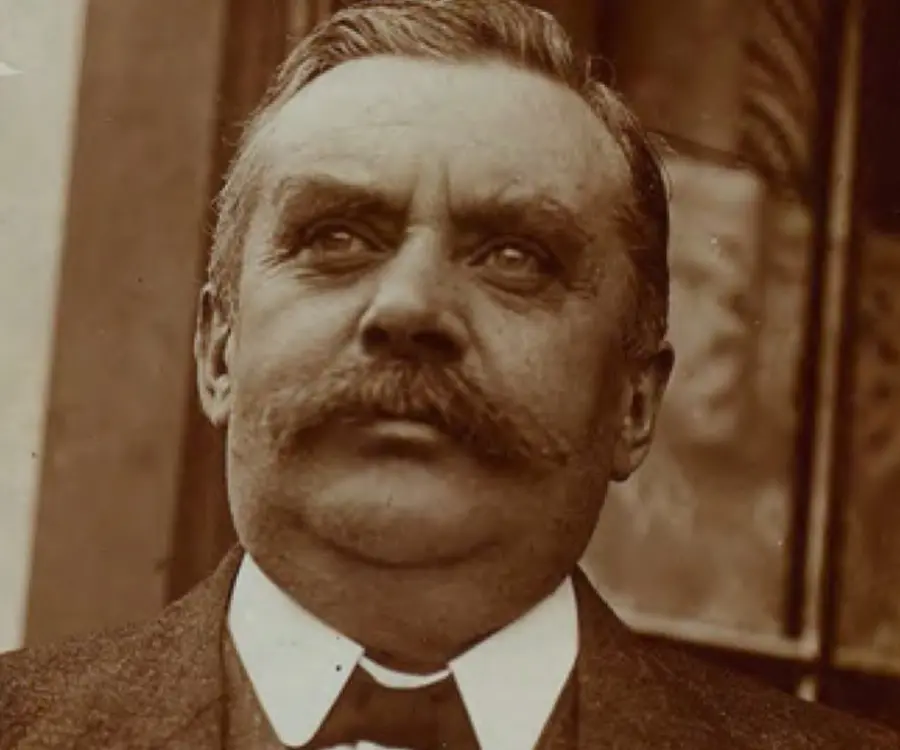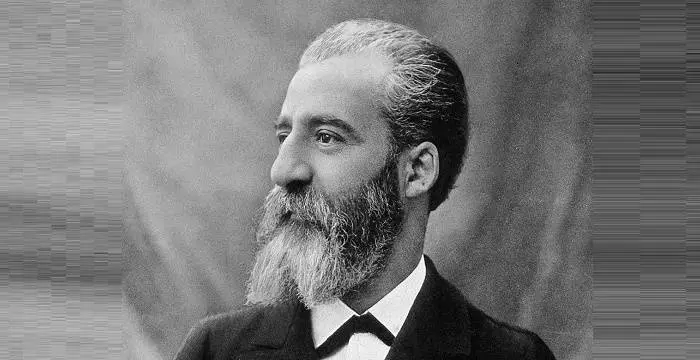
Alfred Werner - Inorganic Chemists, Life Achievements and Personal Life
Alfred Werner's Personal Details
Alfred Werner was a Swiss chemist and the founder of coordination chemistry
| Information | Detail |
|---|---|
| Birthday | December 12, 1866 |
| Died on | November 15, 1919 |
| Nationality | Swiss |
| Famous | Scientists, Chemists, Inorganic Chemists |
| Spouses | Emma Gieskerand |
| Childrens | Alfred, Charlotte |
| Universities |
|
| Birth Place | Mulhouse, Haut-Rhin, Alsace, France |
| Gender | Male |
| Father | Jean-Adam Werner |
| Mother | Salomé Jeanette Tesché |
| Sun Sign | Sagittarius |
| Born in | Mulhouse, Haut-Rhin, Alsace, France |
| Famous as | Chemist |
| Died at Age | 52 |
// Famous Chemists
Henry Cavendish
Henry Cavendish was a theoretical chemist and physicist, renowned for discovery of hydrogen and calculation of the mass of earth. To know more about his childhood, profile, timeline and career read on
Walter Kohn
Nobel Laureate Walter Kohn was an Austrian-born American theoretical chemist and physicist. Check out this biography to know about his childhood, life, achievements, works & timeline.
Jabir Ibn Hayyan
Jabir Ibn Hayyan was a medieval era polymath. Check out this biography to know about his life, works and achievements.
Alfred Werner's photo
Who is Alfred Werner?
Alfred Werner was a Swiss chemist and the founder of coordination chemistry. His research into the structure of coordination compounds won him the 1913 Nobel Prize in Chemistry. Before him, the study of concepts such as valence bonding and geometry in metal amine complexes was confusing. He revolutionized the fields of inorganic chemistry and stereochemistry. His work has found applications in many fields such as organic chemistry, analytical chemistry, biochemistry, geochemistry, and mineralogy, and thus he demonstrated that stereochemistry is not limited to organic chemistry but is a general phenomenon. As a researcher, he was dedicated to his work and earned the reputation of a hard taskmaster. Outside the lab, he was a sociable man who dabbled in a game of billiards, chess, or the Swiss card game, Jass with his friends. He traveled extensively for his lectures and scientific meetings and loved holidaying in the mountains. He was a gifted speaker and was known to provide convincing and clear explanations of to problems. During his short life, he published numerous papers on his research that drew both praise and criticism. He was recipient of numerous honors and memberships to renowned societies.
// Famous Scientists
Juliane Koepcke
Juliane Koepcke is a German-Peruvian biologist, who was the lone survivor among the 92 passengers and crew of the ill-fated LANSA Flight 508 that crashed in the Peruvian rainforest on 24 December 1971. Know more about her life in this biography.
Henry Cavendish
Henry Cavendish was a theoretical chemist and physicist, renowned for discovery of hydrogen and calculation of the mass of earth. To know more about his childhood, profile, timeline and career read on
Konstantin Tsiolkovsky
Konstantin Tsiolkovsky was a Russian rocket scientist and a pioneer of astronautics. This biography provides detailed information about his childhood, family, personal life, career, achievements, etc.
Childhood & Early Life
Alfred Werner was born on December 12, 1866, in Mulhouse, Alsace in France. He was the fourth and youngest child born to Jean-Adam Werner and his second wife, Salomé Jeanette Tesché. His father worked as a foundry worker and was a former locksmith whereas his mother hailed from a wealthy family.
At the time of his birth Alsace was annexed by Germany but his family continued to speak French. His political and cultural sympathies were with France which induced a spirit of rebellion and resistance in him.
His did schooling at the “ÉcoleLibre des Frères” in Mulhouse from 1872 to 1878. He then studied Chemistry at “École Professionelle” until 1885. His interest in Chemistry began to nurture from here which prompted him to conduct his first chemical research at the age of 18.
He spent one year of compulsory military service in Karlsruhe during which he attended lectures at “Technische Hochschule” [Technical High School].
In 1886, he joined “Eidgenössisches Polytechnikum” [Swiss Federal Institute of Technology] in Zurich and obtained a Diploma in Technical Chemistry in 1889.
He received his doctorate in 1890, from the University of Zurich, because the Polytechnikum was not authorized to grant doctorates until 1909. His thesis dealt with the spatial arrangements of the atoms in molecules containing nitrogen.
Career
After getting his Diploma, Werner got a job of an Assistant in Professor Georg Lunge’s laboratory at the Zurich Technical High School. His collaboration with Professor Arthur Hantzsch yielded his first research publication, ‘Überräumliche Anordnungen der Atome in stickstoffhaltigen Molekülen’ (1890), which was also his doctoral dissertation.
In his dissertation, he extended Joseph Achille Le Bel and Jacobus Henricusvan't Hoff's concept of the tetrahedral carbon compound to the nitrogen compound that explained many cases of geometrically isomeric trivalent nitrogen derivatives. It was met with dissent by Victor Meyer, Karl von Auwers, Eugen Bamberger, and others but now stands as one of the cornerstones of stereochemistry.
His second paper was his Habilitationsschrift [an original article required to qualify for a teaching position at a university] titled ‘Beiträgezur Theorie der Affinität und Valenz’ (1891) that focused on the theory of affinity and valence. In this article, he replaced August Kekulé’s concept of rigidly directed valences with a more flexible approach where affinity was viewed as a variously divisible, attractive force emanating from the center of an atom and acting equally in all directions.
For a brief period, he worked on thermo-chemical studies with Marcellin Berthelot at the “Collège de France” in Paris, but later returned to the Technical High School as a Privatdocent [unsalaried lecturer] in 1892. While working on his thesis, he laid the groundwork for his work on spatial relationships of atoms.
His third, and perhaps most important, technical paper, ‘Beitragzur Konstitutionanorganischer Verbindungen’, was published in 1893 in which he had proposed the basic postulates of his coordination theory. It was based on a “dream” where he came up with the solution to “molecular compounds”. The article, conceived despite his limited knowledge of inorganic chemistry, made him an overnight success.
In 1893, he resigned from his post and took up the position of an “Associate Professor” at the University of Zurich.
Two years later, in 1895, he became a “Professor of Chemistry” at the age of 29. The same year, he became a naturalized citizen of Switzerland and was offered posts at Vienna, Basle and Wurzburg. He chose to remain in Zurich and continued his lectures on organic and, in 1902, inorganic chemistry.
His coordination theory helped place thousands of inorganic compounds on a uniform basis and explain their relationships to each other in a simple manner. Since it was largely theoretical, the concept was challenged by many. He teamed up with his students to study and prepare new series of molecular compounds. This led to his discovery of optically-active isomers. He divided metal-ammines [now called “Werner complexes”] into two classes – those with coordination number six (given an octahedral configuration) and those with coordination number four (given a square planar or tetrahedral configuration).
After almost 25 years of research, he discovered not just coordination compounds, but also numerous unknown compounds that aided his theory. In 1913, his research into the structure of coordination compounds earned him the Nobel Prize in Chemistry.
The following year, he was awarded an honorary doctorate in technical sciences by ETH Zurich “in honor of his outstanding work in the field of general chemistry, which also seems to promote technology”.
Major Works
Werner’s most significant work lies in the field of coordination chemistry. He was the first person to propose that coordination compounds containing complex ions could have correct structures. With this insight, chemists could rationalize the number of isomers of coordination compounds which led to new fields of research in organic chemistry.
He also finds a place in the history of the periodic table. In 1905, he separated the lanthanide elements [atomic numbers 58 -71] from others and reorganized the table which is used even today.
Awards & Achievements
He is often called the “founder of coordination chemistry” and his contributions in the field of stereochemistry are insurmountable. His proposal of the octahedral configuration of transition metal complexes was awarded the “Nobel Prize in Chemistry” in 1913 making him the first inorganic chemist to win the prize.
He published two books in 1904, ‘Neuere Anschauungen auf dem Gebiete der anorganischen Chemie’ [New Ideas in Inorganic Chemistry] and ‘Lehrbuch der Stereochemie’ [Textbook of Stereochemistry].
He was a member of many prestigious organizations namely the “British Chemical Society” (Foreign Member), “German Academy of Science”, and “German Bunsen Society for Applied Physical Chemistry”.
Personal Life & Legacy
His mother had converted from Protestantism to Catholicism and thus, he was raised as Roman Catholic. In spite of his Catholic upbringing, Werner’s inclination towards religion was minimal in his later life.
In 1894, he married Emma Gieskerand and became a naturalized Swiss citizen thereafter. A son, Alfred and a daughter, Charlotte were born to them.
His health began to deteriorate at an early age and by 1913, he was suffering from arteriosclerosis of the brain which was further aggravated by his excessive drinking and long working hours. The condition forced him to give up his general lectures in 1915 and in 1919, he gave up his Professorship.
On November 15, 1919, Werner breathed his last at a relatively young age of 52. He died in Burghölzli, a psychiatric hospital in Zurich, Switzerland, a few weeks short of his 53rd birthday.
Trivia
Alfred Werner’s Nobel Prize is the first to be awarded in the field of inorganic chemistry. It was also the first time the prize in Chemistry was awarded to a Swiss national.
// Famous Inorganic Chemists
William Ramsay
William Ramsay was a Nobel Prize winning chemist who discovered the ‘noble gases’. To know more about his childhood, profile, timeline and career read on
Paul Hermann Müller
Paul Hermann Muller was a Swiss Chemist who won the Nobel Prize in Physiology or Medicine for his discovery of a form of DDT. This biography profiles his childhood, life, research, achievements and timeline.
Henri Moissan
Ferdinand Frederick Henri Moissan was a French Chemist who won the Nobel Prize in Chemistry in 1936. Check out this biography to know about his childhood, life, achievements, works & timeline.
Alfred Werner's awards
| Year | Name | Award |
|---|---|---|
Other | ||
| 0 | Nobel Prize for Chemistry (1913) | |
Alfred Werner biography timelines
- // 12th Dec 1866Alfred Werner was born on December 12, 1866, in Mulhouse, Alsace in France. He was the fourth and youngest child born to Jean-Adam Werner and his second wife, Salomé Jeanette Tesché. His father worked as a foundry worker and was a former locksmith whereas his mother hailed from a wealthy family.
- // 1886 To 1889In 1886, he joined “Eidgenössisches Polytechnikum” [Swiss Federal Institute of Technology] in Zurich and obtained a Diploma in Technical Chemistry in 1889.
- // 1890 To 1909He received his doctorate in 1890, from the University of Zurich, because the Polytechnikum was not authorized to grant doctorates until 1909. His thesis dealt with the spatial arrangements of the atoms in molecules containing nitrogen.
- // 1890After getting his Diploma, Werner got a job of an Assistant in Professor Georg Lunge’s laboratory at the Zurich Technical High School. His collaboration with Professor Arthur Hantzsch yielded his first research publication, ‘Überräumliche Anordnungen der Atome in stickstoffhaltigen Molekülen’ (1890), which was also his doctoral dissertation.
- // 1891His second paper was his Habilitationsschrift [an original article required to qualify for a teaching position at a university] titled ‘Beiträgezur Theorie der Affinität und Valenz’ (1891) that focused on the theory of affinity and valence. In this article, he replaced August Kekulé’s concept of rigidly directed valences with a more flexible approach where affinity was viewed as a variously divisible, attractive force emanating from the center of an atom and acting equally in all directions.
- // 1892For a brief period, he worked on thermo-chemical studies with Marcellin Berthelot at the “Collège de France” in Paris, but later returned to the Technical High School as a Privatdocent [unsalaried lecturer] in 1892. While working on his thesis, he laid the groundwork for his work on spatial relationships of atoms.
- // 1893His third, and perhaps most important, technical paper, ‘Beitragzur Konstitutionanorganischer Verbindungen’, was published in 1893 in which he had proposed the basic postulates of his coordination theory. It was based on a “dream” where he came up with the solution to “molecular compounds”. The article, conceived despite his limited knowledge of inorganic chemistry, made him an overnight success.
- // 1893In 1893, he resigned from his post and took up the position of an “Associate Professor” at the University of Zurich.
- // 1894In 1894, he married Emma Gieskerand and became a naturalized Swiss citizen thereafter. A son, Alfred and a daughter, Charlotte were born to them.
- // 1895 To 1902Two years later, in 1895, he became a “Professor of Chemistry” at the age of 29. The same year, he became a naturalized citizen of Switzerland and was offered posts at Vienna, Basle and Wurzburg. He chose to remain in Zurich and continued his lectures on organic and, in 1902, inorganic chemistry.
- // 1904He published two books in 1904, ‘Neuere Anschauungen auf dem Gebiete der anorganischen Chemie’ [New Ideas in Inorganic Chemistry] and ‘Lehrbuch der Stereochemie’ [Textbook of Stereochemistry].
- // 1905He also finds a place in the history of the periodic table. In 1905, he separated the lanthanide elements [atomic numbers 58 -71] from others and reorganized the table which is used even today.
- // 1913After almost 25 years of research, he discovered not just coordination compounds, but also numerous unknown compounds that aided his theory. In 1913, his research into the structure of coordination compounds earned him the Nobel Prize in Chemistry.
- // 1913He is often called the “founder of coordination chemistry” and his contributions in the field of stereochemistry are insurmountable. His proposal of the octahedral configuration of transition metal complexes was awarded the “Nobel Prize in Chemistry” in 1913 making him the first inorganic chemist to win the prize.
- // 15th Nov 1919On November 15, 1919, Werner breathed his last at a relatively young age of 52. He died in Burghölzli, a psychiatric hospital in Zurich, Switzerland, a few weeks short of his 53rd birthday.
// Famous Sagittarius Celebrities peoples
Billie Eilish
Billie Eilish Pirate Baird O’Connell is an American singer and songwriter. Check out this biography to know about her childhood, family, personal life, birthday, etc.
Jacelyn Reeves
Jacelyn Reeves is a former flight attendant who once had a fling with Clint Eastwood. Check out this biography to know about her birthday, childhood, family life, achievements and fun facts about her.
Edmund Kemper
Edmund Kemper is a convicted serial killer from America who murdered ten people. Check out this biography to know about his childhood, life, crimes and other facts about him.
Pietro Boselli
Pietro Boselli is an Italian model, engineer, teacher, and fitness athlete who became famous as the ‘world’s sexiest math teacher’. Check out this biography to know about his birthday, childhood, family life, achievements and fun facts about him.
Niqoles Heard
Lil Niqo is an American rapper and musical artist. Let’s take a look at his family and personal life including age, date of birth, net worth, girlfriends, and fun facts.
Ted Nugent
Ted Nugent is a hard rock musician known for his hits ‘Stranglehold’ and ‘Cat Scratch Fever’. This biography of Ted Nugent provides detailed information about his childhood, life, achievements, works & timeline.
Alfred Werner's FAQ
What is Alfred Werner birthday?
Alfred Werner was born at 1866-12-12
When was Alfred Werner died?
Alfred Werner was died at 1919-11-15
Where was Alfred Werner died?
Alfred Werner was died in Zurich, Switzerland
Which age was Alfred Werner died?
Alfred Werner was died at age 52
Where is Alfred Werner's birth place?
Alfred Werner was born in Mulhouse, Haut-Rhin, Alsace, France
What is Alfred Werner nationalities?
Alfred Werner's nationalities is Swiss
Who is Alfred Werner spouses?
Alfred Werner's spouses is Emma Gieskerand
Who is Alfred Werner childrens?
Alfred Werner's childrens is Alfred, Charlotte
What was Alfred Werner universities?
Alfred Werner studied at University of Zurich, ETH Zurich
Who is Alfred Werner's father?
Alfred Werner's father is Jean-Adam Werner
Who is Alfred Werner's mother?
Alfred Werner's mother is Salomé Jeanette Tesché
What is Alfred Werner's sun sign?
Alfred Werner is Sagittarius
How famous is Alfred Werner?
Alfred Werner is famouse as Chemist















